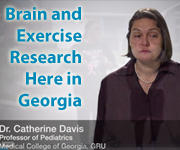When fifth-grader Trevor Nelson arrives at school, he doesn’t linger in the halls or go to the cafeteria for breakfast. Every other morning, he heads for the gym.
“I just love to run,” said Trevor, “so I figured I’d do this.”
From 7:15 to 7:45 a.m., members of Yargo Elementary School’s fifth-grade running club sprint, zigzag and race around the gymnasium as physical education teacher Pam Rogan calls the drills.
The kids are noisy and energetic despite the early hour.
One day the participants will play running games, like tag, and the next they will do sprints and bear claws. “It’s different every day,” said Rogan, who has taught for 13 years at Yargo, a school in Winder, west of Athens.
Yargo has 854 students, about 110 of whom are in the fifth grade. Rogan started the program in fall 2010, and now, on an average day, her club attracts nearly 75 percent of the class – about 60 boys and 15 girls. Boys and girls run on alternating days. Each group runs two or three mornings each week.
“Last year we had a lot of obese kids, and we wanted to try to increase their activity time,” said Rogan. “A lot of these kids go home and are by themselves and really don’t have the opportunity to exercise.”
It’s the type of program that Gov. Nathan Deal and Georgia public health leaders would like to see spread across the state.
Last week, Deal announced a major statewide initiative to address the problem of obesity, calling it “one of the greatest challenges we face.’’
The obesity program would combine efforts of state agencies, businesses, health care organizations, the philanthropic community, and Atlanta professional sports teams.
The initiative’s goals include promoting more physical activity and improving nutrition in schools.
It represents the next step in the state’s SHAPE program in schools, which includes a fitness assessment of students, measuring their strength, flexibility and endurance.
SHAPE now features a new website, Georgiashape.org, which lists cooking, exercise and nutrition information and has a directory of fitness programs, such as YMCAs, and farmers markets by ZIP code.
A war on inactivity
The state’s Public Health commissioner, Dr. Brenda Fitzgerald, said last week that a goal is to see, in schools, “30 minutes of movement, every child and every day.’’
At Yargo Elementary, club participation is free and open to all fifth-graders who are keeping up with their schoolwork.
Participants miss homeroom and breakfast, but the cafeteria offers bags of food the students can eat in class afterward.
Several elementary schools throughout the state are encouraging students to be physically active through running clubs, including schools in Fayette County, Lowndes County, Fulton County and, starting recently, Whitfield County.
Young people 6 to 17 should have at least 60 minutes of physical activity every day, according to the 2008 Physical Activity Guidelines for Americans, published by the U.S. Department of Health and Human Services.
But a 2009 national survey found that only 18 percent of high school students had been physically active for 60 minutes every day during the previous week, and only 33 percent participated in daily physical education classes, according to the CDC.
Experts fear the consequences could be long-lasting.
“I think we have an obesity epidemic due to a decline in physical activity,” said public health professor Russell Pate, director of Children’s Physical Activity Research Group at the University of South Carolina. “I worry about this generation of kids and what this obesity epidemic will mean to them when they are 30 to 40 years old.”
Inactivity, coupled with poor eating habits, can lead to obesity and increased risks of diabetes, asthma, high blood pressure and heart disease.
In contrast, active kids are more likely to have stronger hearts and lungs, better endurance, and stronger muscles and bones, Pate said during his presentation at the University of Georgia Ramsey Lecture Series in late March. Pate led the initiative to develop national recommendations on physical activity and public health for the CDC in 1995.
Research suggests regular physical activity is a buffer against depression and anxiety, increases self-esteem among children and may help improve academic performance, according to the CDC.
Research also suggests that being more active improves cognitive function, not just in the classroom, but in everyday life.
Game-playing adds to the benefit
Playing games that call for quick decisions in an environment that varies from moment to moment has a positive impact on the brain, said Bryan McCullick, who coordinates the Georgia Physical Education Teachers Workshop at the University of Georgia’s College of Education.
McCullick also designs age-appropriate games to maximize the physical and cognitive benefits of physical activity for after-school programs in Athens-Clarke County. He praised Rogan for incorporating game days into the running club.
“It’s not enough to have them run,” said McCullick. “That’s beneficial, but it could be even more beneficial to have them learn how to be competent game players so that they are mentally challenged.”
Club members at Yargo earn a colorful plastic tag that laces into their sneakers for every two miles, or 22 laps around the gym, they run. Some students have run the equivalent of a half-marathon, 13.1 miles.
Fifth-grader and club member Gavin Sellers says he enjoys playing the games and sprinting around Yargo’s gym with his friends. Gavin and Trevor Nelson have both passed the half-marathon mark this school year.
Rogan plans to continue the program next year, and hopes rising fifth-graders will join.
“As-fifth graders, 10- and 11-year-olds, they are getting to the point where they can make decisions about their life and make the choice to come and increase their health,” said Rogan. “[By making it voluntary] we kind of wanted to give them a chance to grow up as well.
Story by Lacey Avery, reprinted with permission from Georgia Health News.



